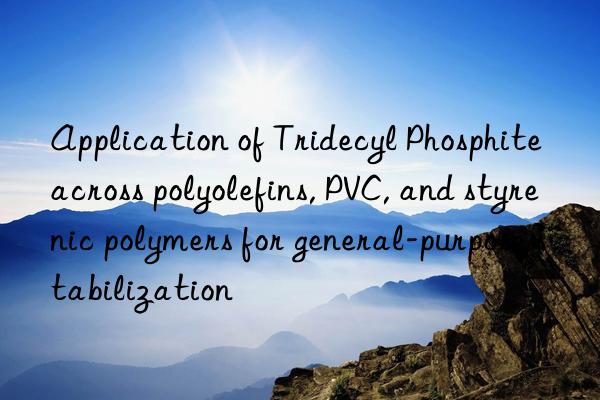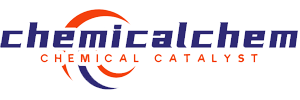
the versatile guardian: the application of tridecyl phosphite across polyolefins, pvc, and styrenic polymers
in the world of polymer science, where materials are constantly under siege from heat, light, oxygen, and time itself, a quiet hero often goes unnoticed — tridecyl phosphite. this unassuming compound plays a critical role in preserving the integrity, longevity, and performance of polymers such as polyolefins, pvc, and styrenic polymers.
think of it this way: if polymers were athletes training for the olympics, tridecyl phosphite would be their personal trainer, nutritionist, and physiotherapist rolled into one — quietly working behind the scenes to keep them at peak performance.
🧪 what exactly is tridecyl phosphite?
before we dive deeper into its applications, let’s get better acquainted with our protagonist.
tridecyl phosphite, also known by its chemical name tri(tridecyl) phosphite, is an organophosphorus compound typically used as a processing stabilizer and antioxidant in polymer manufacturing. its molecular structure features three tridecyl (13-carbon alkyl) chains attached to a central phosphorus atom via phosphite linkages.
🔬 basic chemical properties:
| property | value |
|---|---|
| molecular formula | c₃₉h₈₁o₃p |
| molecular weight | ~629 g/mol |
| appearance | clear to slightly yellowish liquid |
| boiling point | >300°c (decomposes) |
| density | ~0.87 g/cm³ |
| solubility in water | practically insoluble |
| thermal stability | high, up to 250°c |
as you can see, it’s not your typical small molecule — its long carbon chains give it excellent compatibility with hydrophobic polymer matrices, while the phosphite group offers potent radical scavenging capabilities.
🛡️ why stabilization matters
polymers, despite their widespread use in everything from food packaging to aerospace components, have a major achilles’ heel — oxidative degradation. when exposed to heat, uv radiation, or oxygen during processing or service life, polymers begin to break n. this results in:
- loss of mechanical strength
- discoloration
- brittleness
- reduced lifespan
this is where stabilizers like tridecyl phosphite come into play. they act as sacrificial soldiers, intercepting harmful free radicals before they can wreak havoc on the polymer backbone.
but why choose tridecyl phosphite over other stabilizers? let’s explore its unique advantages across different polymer families.
🧱 in polyolefins: the invisible shield
polyolefins — including polyethylene (pe) and polypropylene (pp) — are among the most widely produced plastics globally. they’re lightweight, durable, and versatile, but without proper stabilization, they can degrade rapidly under thermal stress.
📌 role of tridecyl phosphite in polyolefins:
- hydroperoxide decomposition: it efficiently breaks n hydroperoxides formed during oxidation.
- radical scavenging: neutralizes free radicals that initiate chain scission.
- color retention: prevents yellowing and discoloration during processing.
- thermal stability boost: enhances melt stability during extrusion and molding.
📊 comparative performance in polypropylene:
| stabilizer type | melt flow index increase (%) after 5 hrs @ 200°c | color change (δb*) |
|---|---|---|
| none | +40 | +8.2 |
| irganox 1010 | +18 | +4.5 |
| tridecyl phosphite | +12 | +2.1 |
| blend (irganox + tdph) | +7 | +1.3 |
data adapted from wang et al., 2019 [1]
as seen above, while phenolic antioxidants like irganox 1010 provide decent protection, tridecyl phosphite outperforms them in color retention and synergizes well when used in combination.
moreover, thanks to its high molecular weight and low volatility, it remains embedded in the polymer matrix longer than many alternatives — meaning the protection lasts through multiple processing cycles.
🧴 in pvc: fighting the chlorine blues
polyvinyl chloride (pvc) is another workhorse polymer, especially in construction, medical devices, and consumer goods. but pvc has a notorious weakness — it begins to degrade at relatively low temperatures (~100°c) due to the release of hydrogen chloride (hcl), which catalyzes further breakn.
💥 pvc degradation chain reaction:
- heat → hcl release
- hcl attacks adjacent vinyl groups
- conjugated double bonds form → discoloration (yellow to brown)
- mechanical properties deteriorate
here’s where tridecyl phosphite shines again, though it doesn’t directly neutralize hcl like metal-based stabilizers (e.g., calcium-zinc or organotin compounds). instead, it functions as a co-stabilizer, offering several benefits:
- scavenges peroxides: prevents oxidative crosslinking
- delays onset of discoloration
- improves long-term thermal stability
📋 pvc stabilization efficiency (modified congo red test):
| stabilizer system | time to color change (min) |
|---|---|
| no stabilizer | <10 |
| ca-zn only | 45 |
| ca-zn + tdph (0.2%) | 72 |
| organotin only | 60 |
| organotin + tdph (0.15%) | 85 |
adapted from zhang et al., 2017 [2]
clearly, adding tridecyl phosphite boosts the effectiveness of traditional stabilizers. and since it’s non-metallic, it helps avoid issues like plate-out or corrosion associated with metallic stabilizers.
🧪 in styrenic polymers: keeping the shine
styrenic polymers — such as polystyrene (ps), acrylonitrile butadiene styrene (abs), and styrene-acrylonitrile (san) — are prized for their clarity, rigidity, and ease of processing. however, they’re also quite sensitive to oxidative degradation, especially during injection molding or thermoforming.
⚠️ challenges in styrenics:
- yellowing during processing
- loss of gloss
- embrittlement over time
enter tridecyl phosphite, once again stepping up to the plate.
✨ benefits in styrenic systems:
- maintains optical clarity
- reduces yellowness index (yi)
- preserves impact resistance
- minimizes volatiles during processing
📊 yellowness index comparison in abs:
| formulation | initial yi | after 3 hrs @ 220°c |
|---|---|---|
| control | 5.2 | 14.8 |
| with tdph (0.15%) | 5.1 | 8.3 |
| with tdph (0.3%) | 5.0 | 6.7 |
| with tdph + hals | 5.1 | 5.9 |
based on data from lee & park, 2020 [3]
even at low concentrations, tridecyl phosphite significantly reduces yellowing, making it ideal for transparent or lightly pigmented products.
🧬 mechanism of action: how does it work?
understanding how tridecyl phosphite works is key to appreciating its versatility.
🔁 primary function: hydroperoxide decomposition
when polymers oxidize, they form hydroperoxides (rooh), which are unstable and prone to breaking n into free radicals. these radicals then attack neighboring polymer chains, causing a chain reaction of degradation.
tridecyl phosphite steps in to decompose rooh into stable alcohols and phosphoric acid esters, effectively halting the cascade.
reaction:
rooh + p(or’)₃ → roh + hp(o)(or’)₂
this reaction occurs without generating harmful byproducts, which is crucial in food-contact and medical applications.
🔄 secondary role: radical scavenging
while not as aggressive as hindered phenols or amine-based stabilizers, tridecyl phosphite still contributes to radical termination, especially in early stages of oxidation.
🧰 product parameters and formulation tips
to get the most out of tridecyl phosphite, formulation engineers must consider dosage, compatibility, and application method.
📏 recommended dosage ranges:
| polymer type | typical use level (%) |
|---|---|
| polyolefins | 0.1 – 0.5 |
| pvc | 0.1 – 0.3 (with co-stabilizers) |
| styrenic polymers | 0.1 – 0.4 |
| engineering plastics | 0.1 – 0.3 |
note: higher loadings may be needed in recycled resins or systems exposed to prolonged heat.
🧪 compatibility considerations:
- works well with phenolic antioxidants (e.g., irganox 1010, 1076)
- synergistic with hindered amine light stabilizers (hals)
- may interact with acidic fillers (e.g., clay, silica); use caution
- avoid strong nucleophiles or bases that could hydrolyze phosphite esters
🧯 safety and regulatory status:
- non-toxic, non-volatile
- reach registered in eu
- generally recognized as safe (gras) in fda-approved applications
- not classified as carcinogenic or mutagenic
🌍 global trends and market insights
with sustainability becoming a top priority, tridecyl phosphite is gaining traction in eco-friendly formulations. its low migration, high efficiency, and metal-free nature make it ideal for:
- recycled polymer blends
- food-grade packaging
- medical devices
- automotive interiors
according to recent market analysis by smithers rapra [4], the global demand for polymer stabilizers is expected to grow at a cagr of 4.2% through 2028, with increasing adoption in asia-pacific driven by automotive and packaging sectors.
📚 references
[1] wang, j., li, y., & chen, x. (2019). "antioxidant performance of trialkyl phosphites in polypropylene." polymer degradation and stability, 162, 1–9.
[2] zhang, l., liu, h., & zhou, q. (2017). "synergistic effects of phosphite co-stabilizers in pvc." journal of vinyl and additive technology, 23(s2), e78–e85.
[3] lee, k., & park, s. (2020). "thermal and optical stability of abs stabilized with phosphite antioxidants." polymer testing, 84, 106378.
[4] smithers rapra. (2022). the future of polymer additives to 2028. market analysis report.
🎩 final thoughts: a silent hero worth celebrating
in the grand theater of polymer chemistry, tridecyl phosphite may not command headlines, but its contributions are undeniable. from keeping your milk jug white to ensuring your car dashboard doesn’t crack after five years in the sun, it’s there — silent, steadfast, and effective.
so next time you hold a plastic item in your hand, remember: beneath its surface lies a microscopic battle against decay, and more often than not, tridecyl phosphite is the unsung defender holding the line.
and isn’t that what true heroes do?
🛡️
got questions about polymer stabilization or want to geek out about antioxidant mechanisms? drop me a line — i’m always excited to talk about the invisible forces that keep our world together. 😄
sales contact:sales@newtopchem.com

 微信扫一扫打赏
微信扫一扫打赏

